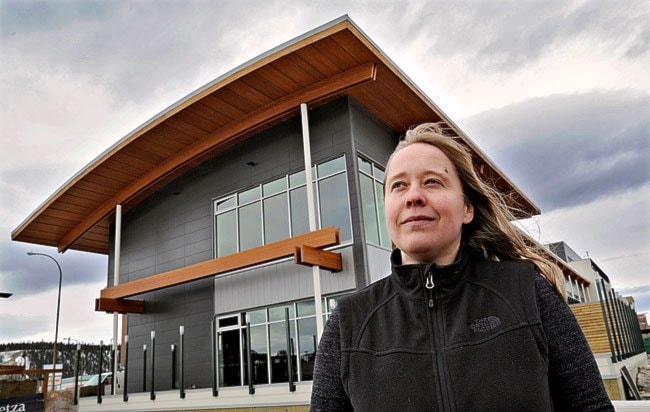The federal government’s Elijah Smith building squats brooding across Main Street from the Hougen Centre’s gaily-painted false fronts; the imposing bulk of government bureaucracy juxtaposed with cheery commercialism and a nod to Yukon history. It’s a contrast that captures Whitehorse’s architectural split personality almost perfectly.
Mary Ellen Read wants to understand why.
“It would be really disappointing if Whitehorse was all Gold Rush era false fronts. But then we have buildings like the legislature, which is this really brutal modernism, and to some people it’s an ugly building but to others it’s a really important building from the ‘60s. Where do these different things come from?”
Read is an architect and designer with Northern Front Studio, and has also been involved with Whitehorse art projects like the DC-3 yarn bomb installation. She’ll be presenting an art talk called Northern Architecture: Past and Present, tomorrow at the Old Fire Hall with Dave Neufeld, an environmental historian.
“We’re talking about why we build what we build in the Yukon,” Read said.
“It’s a whole discussion about that. It’s looking at historical references, external impacts, crafts, scale ... sort of this free-for-all discussion we’re going to have talking about architecture not just as buildings but as everything we build and why.”
Architecture is much more than the way we design big buildings, Read said. It can be an art form unto itself, and is often reflective of the people and the environment it springs from.
[image2]
“Whitehorse has a really industrial feel because of our limited resources. Most of our materials have to come from somewhere else, and therefore it’s become really pragmatic. What’s going to be durable? I’d like to think we’re changing, that we’re starting to change the things we value. What’s our city going to look like as it grows over the next 20 years?”
Read and Neufeld won’t be focused only on Whitehorse. Dawson City is another community that has a very unique architectural feel. Some of that is intentional, and some is totally organic, Read said. Finding that balance is important, not just because it determines how our buildings look, but also how we feel about them.
“The talk is really about the different ways that people respond to what Yukon architecture is. Some people see it as being really pragmatic; you need a really solid building envelope, you need to combat the weather. Some people see it as “how do we connect to this amazing landscape, how do we use local resources,” Read said.
Yukon architecture is moulded by a number of factors, including our harsh climate and a strong sense of history, Read said. But it’s more than just our buildings.
“It’s a really broad topic. What I’m hoping to explain is that architecture isn’t just about buildings. It’s about everything that we make and do from small-scale art to big-scale infrastructure. It’s not just big buildings, it’s little small installations and cabins and everything, the full range of how we look at our world,” Read said.
Underneath Whitehorse’s veneer of industrial steel and concrete, there are many factors at play. A lot of our postmodern architecture focuses on incorporating themes and histories from the past into new developments, and finding a way to represent a more-inclusive Yukon culture.
A perfect example is the Kwanlin Dun Cultural Centre. It draws on First Nations structures and traditions to create a place that not only houses a cultural hub, but also feels like one.
“The historic reference is a big part of it. We talk a little about First Nations. Dave will touch on the historical structures of First Nations and we’ll talk about cultural centres and why they look the way they do,” she said.
The talk runs from 5:30 p.m. to 7 p.m. Thursday, April 11 at the Old Fire Hall.
Contact Jesse Winter at
jessew@yukon-news.com
